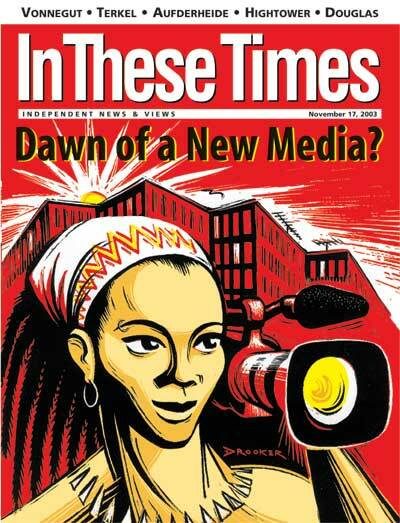
Many progressive Americans sense that we are at a watershed moment in our relationship to the mainstream media. Progressive media outlets themselves feel that they, too, may be at a turning point.
The media reform movement, spearheaded by Bob McChesney and others, aroused only marginal passion several years ago but it took off like a rocket in 2003 as a result of unprecedented FCC arrogance, shameless media jingoism and superb grassroots organizing. This past summer, the scales began to fall off the eyes of the newsmagazines and TV networks (with the exception of CNN), and they began asking tough questions about the motives and honesty of Team Bush. The bestseller list is no longer the province of the far right, as Al Franken, Paul Krugman, Michael Moore, Molly Ivins and others soar to the top. Web sites like MoveOn.org have become major political players. And now we have the highly energized National Conference on Media Reform.
Many of us, then, are thinking about how to capitalize on such a moment. Can we turn this constellation of events into an ongoing and effective coalition with clout? Can we vie with the right—which dominates public affairs programming and now has its own cable news channel—to shape what becomes the “common sense” about what kind of public policy is best for the country?
To answer these questions we need to remind ourselves of a little history. Democrats and progressives today are roughly where Republicans and the new right were in the mid- to late-1970s: out of power and with a highly motivated, even enraged base determined to change the course of national politics. So what did the right do during the dark post-Watergate years? They studied the strategy of the liberals and left in the ’60s and ’70s, then copied or trumped them.
From the right’s point of view, the news came to be dominated first by the Civil Rights movement—with its explosive, opinion-altering imagery—then by the anti-war movement, the women’s movement and the environmental movement. They heard chants and sound bites that got major coverage, from “credibility gap” to demonstrators yelling “The whole world is watching” during the police riots at the 1968 Democratic convention to feminists asserting “the personal is political.” They saw previously marginal political organizations from SDS to the Black Panthers to NOW use provocative strategies to get on the air (even though the coverage they got was mixed at best).
They saw Walter Cronkite turn against the war, Gloria Steinem appear on the “Dick Cavett Show,” Eldridge Cleaver’s Soul on Ice become a bestseller. They saw how liberals had used the courts and public opinion about social justice to get around a racist and sexist Congress in order to promote integration and secure a woman’s right to control her reproductive life. In other words, from their point of view, liberals and the left were setting the media agenda.
The right did not take this lying down—they studied journalistic routines and preferences and learned how to cater to them so they could set the agenda instead. What had been for the left fairly spontaneous, often ad hoc media tactics, became in the hands of the right a much more calculated and coordinated long-term strategy. Phyllis Schlafly, for example, staged “counter” events to compete with feminist conferences and crafted newsworthy, titillating sound bites insisting that the ERA would mandate coed bathrooms. And she won the day on the ERA.
The right also moved behind the scenes. They shrewdly developed their own organizations to influence the media, and with tons more money than the Black Panthers ever had. But the Heritage Foundation et al. were not out in the streets; they were in their cubicles, cranking out position paper after position paper for journalists. These think tanks also began funding books, and then buying them in bulk so they’d rise to the bestseller list.
The right brilliantly invented the rhetoric of inversion and deployed it in their sound bites so that common sense got turned on its head. “Class warfare” suddenly referred to efforts to tax the rich, patriarchy was renamed “family values,” and poverty became “cycle of dependency.” Most recently, “leave no child behind” (stolen from the Children’s Defense Fund) became a fig leaf covering up efforts to defund virtually everything that helps poor kids in the United States. And the right repeatedly charged the media with displaying a “liberal bias,” accused NPR of being communist and got its funds cut in Congress, and pressured all the networks and PBS to feature more right-wing opinions. (Of course, it didn’t hurt that under Reagan the FCC began its long-term deregulatory slide, which included eliminating the Fairness Doctrine and clearing the way for media consolidation.) And, well, here we are.
It is time to cast off our collective amnesia about how the right stole these strategies from the left and then made them their own. Because in forgetting this theft, we see the right’s tactics as de novo, as theirs, as too shabby or pandering to reclaim. But if we are to take advantage of the current momentum, a moment that gains enormous sustenance from most people’s fear that they are now living in a cross between a theocracy and a monarchy, we need to play a much stronger role in setting the media agenda. We need not think that we have to copy from the right to succeed. That cripples us. Instead, we need to think about rediscovering our own agenda-setting roots from the ’60s, study which revisions of them by the right have worked, and then forge ahead.
For example, I have gotten into debates with other progressives whom I respect enormously on the need for sound bites that play well and help people see things differently. My colleagues have argued that sound bites dumb things down, and that’s not what the left is about. Fair enough. But you know, I think “Equal Pay for Equal Work” was a great sound bite, and while we’re not there yet, it helped revolutionize many women’s pay scales and, thus, their lives.
So, first, let’s look at what’s already working. Despite the media shift to the right, we are getting our foot in the door. Sut Jhally’s highly successful Media Education Foundation (which he started from nothing with his own credit cards) now sells media literacy video tapes to schools, colleges and universities all across the country, and millions of students see them. Progressive Web sites are getting massive numbers of hits, and actions as varied as anti-WTO demonstrations, fundraising for Howard Dean, and the anti-war efforts of MoveOn.org and others have been impressively well-coordinated online. Nation editor Katrina vanden Heuvel does get on PBS’s “Newshour” and cable shows like “Media Matters”; Bob McChesney and John Nichols did appear on Bill Moyers’ “NOW”; and Michael Moore’s Bowling for Columbine was one of the longest running films in theaters last year and won an Oscar. Time to push the door open wider.
Progressives are rediscovering the enormous power of satire and humor (remember guerilla theater, W.I.T.C.H. hexing Wall Street and the various yippie antics?) to discredit the status quo. More to the point, Al Franken, Michael Moore and Paul Krugman do not have to rely on bulk sales by partisan organizations to keep their books on the top: people are, actually, like, reading these books. We may get syndicated progressive talk show hosts or even a progressive network; the TV show “Progressive Week in Review,” sponsored by Ben & Jerry’s may be a bit further off, but not because people wouldn’t watch it.
And while many of us have made bashing the mainstream media a regular pastime, let’s not forget how disgusted many journalists are right now. The New York Times does give us Frank Rich and Paul Krugman; even the anti-feminist, Clinton-bashing Maureen Dowd has turned to eviscerating Bush. Newsweek has had a series of terrific investigative reports about the failed hunt for Osama bin Laden and the complete (and ideologically driven) bungling of post-war planning for Iraq.
What continues to frustrate us? Superficial, sloppy reporting about Iraq and the virtual neglect of Afghanistan; the inability of progressives who might know something about a range of issues to get their views on the nightly news or political talk shows; the dominance of talk radio by right-wing, homophobic, racist, sexist Neanderthals; the marginalizing of what we see as utter common sense as “radical” or “left wing,” even though, for example, most Americans agree with us that we need a national health care system now; and all of this is made possible by the corporate stranglehold on media ownership.
So how do we confront these problems?
Rather than focus on how we’re shut out, assess our strengths and build on them.
Work to develop more cooperative relations with the mainstream media and to pressure them, constantly, to include progressive assessments of issues on radio and TV.
Design a more consistent and reliable agenda-setting machine that issues (or coordinates the issuing of) timely press releases and studies, especially those that show the similarities between many people’s views and the policy positions of progressives.
Improve fundraising strategies. (I know, I know—but there are people with money out there who don’t want to be ruled by an American Taliban either.)
Most of these things are already being done, with varying degrees of success, but they need to be brought together and managed more effectively and strategically. All of which leads to?
Establish an organization, or beef up an existing one that will be the agreed-upon clearinghouse for coordinating collective efforts.
No one wants to reinvent the wheel and have a new organization do what existing ones already handle just fine. Rather, we need a kind of overarching information office that synchronizes all these efforts into an agenda-altering juggernaut.
None of this is quick or easy. It took the Republicans about 10 years to break out of the blocks (in the mid-’80s); by the mid-’90s, even a Democratic president had to respond to, co-opt and, in the end, be savaged by their agenda. We have to learn something that is hard for many of us, especially given the emergency before us: patience—and the ability to take the long view.
In other words, we need a blueprint for a more tightly coordinated and, dare I say it, professional organization that focuses, like the proverbial laser beam, on media strategy. Others may disagree with this proposal, but I think it’s crucial. I—like many of you—have been to various alternative media conferences over the years. We all get jazzed up and reaffirmed, vow to change the media landscape, and then go back to our individual, sometimes isolated jobs where we become, once again, too overburdened to see such a mission through. Or we get bogged down in debates between purists and pragmatists. Given the deadly serious dangers Team Bush poses, the latter is a luxury we cannot afford.
Others with more organizational savvy than I, who actually have on-the-ground experience in the Independent Press Association, AlterNet, FAIR or MoveOn, could no doubt propose various blueprints for how to proceed. But we need a few people whose only job would be to coordinate and deploy all of our efforts along a series of clearly defined goals that would then be updated every few months. The articles that follow provide more detailed assessments of our failures, successes and new opportunities. But let’s keep our eye on the ball as we plan for the future. Team Bush is the most dangerous administration we’ve ever had—and that’s saying something. They must not be permitted to take our country from us. And a savvy, hardnosed, multi-pronged yet synchronized media strategy is essential to this end.
The media reform movement, spearheaded by Bob McChesney and others, aroused only marginal passion several years ago but it took off like a rocket in 2003 as a result of unprecedented FCC arrogance, shameless media jingoism and superb grassroots organizing. This past summer, the scales began to fall off the eyes of the newsmagazines and TV networks (with the exception of CNN), and they began asking tough questions about the motives and honesty of Team Bush. The bestseller list is no longer the province of the far right, as Al Franken, Paul Krugman, Michael Moore, Molly Ivins and others soar to the top. Web sites like MoveOn.org have become major political players. And now we have the highly energized National Conference on Media Reform.
Many of us, then, are thinking about how to capitalize on such a moment. Can we turn this constellation of events into an ongoing and effective coalition with clout? Can we vie with the right—which dominates public affairs programming and now has its own cable news channel—to shape what becomes the “common sense” about what kind of public policy is best for the country?
Look to the past
To answer these questions we need to remind ourselves of a little history. Democrats and progressives today are roughly where Republicans and the new right were in the mid- to late-1970s: out of power and with a highly motivated, even enraged base determined to change the course of national politics. So what did the right do during the dark post-Watergate years? They studied the strategy of the liberals and left in the ’60s and ’70s, then copied or trumped them.
From the right’s point of view, the news came to be dominated first by the Civil Rights movement—with its explosive, opinion-altering imagery—then by the anti-war movement, the women’s movement and the environmental movement. They heard chants and sound bites that got major coverage, from “credibility gap” to demonstrators yelling “The whole world is watching” during the police riots at the 1968 Democratic convention to feminists asserting “the personal is political.” They saw previously marginal political organizations from SDS to the Black Panthers to NOW use provocative strategies to get on the air (even though the coverage they got was mixed at best).
They saw Walter Cronkite turn against the war, Gloria Steinem appear on the “Dick Cavett Show,” Eldridge Cleaver’s Soul on Ice become a bestseller. They saw how liberals had used the courts and public opinion about social justice to get around a racist and sexist Congress in order to promote integration and secure a woman’s right to control her reproductive life. In other words, from their point of view, liberals and the left were setting the media agenda.
Set the agenda
The right did not take this lying down—they studied journalistic routines and preferences and learned how to cater to them so they could set the agenda instead. What had been for the left fairly spontaneous, often ad hoc media tactics, became in the hands of the right a much more calculated and coordinated long-term strategy. Phyllis Schlafly, for example, staged “counter” events to compete with feminist conferences and crafted newsworthy, titillating sound bites insisting that the ERA would mandate coed bathrooms. And she won the day on the ERA.
The right also moved behind the scenes. They shrewdly developed their own organizations to influence the media, and with tons more money than the Black Panthers ever had. But the Heritage Foundation et al. were not out in the streets; they were in their cubicles, cranking out position paper after position paper for journalists. These think tanks also began funding books, and then buying them in bulk so they’d rise to the bestseller list.
Turn the tables
The right brilliantly invented the rhetoric of inversion and deployed it in their sound bites so that common sense got turned on its head. “Class warfare” suddenly referred to efforts to tax the rich, patriarchy was renamed “family values,” and poverty became “cycle of dependency.” Most recently, “leave no child behind” (stolen from the Children’s Defense Fund) became a fig leaf covering up efforts to defund virtually everything that helps poor kids in the United States. And the right repeatedly charged the media with displaying a “liberal bias,” accused NPR of being communist and got its funds cut in Congress, and pressured all the networks and PBS to feature more right-wing opinions. (Of course, it didn’t hurt that under Reagan the FCC began its long-term deregulatory slide, which included eliminating the Fairness Doctrine and clearing the way for media consolidation.) And, well, here we are.
It is time to cast off our collective amnesia about how the right stole these strategies from the left and then made them their own. Because in forgetting this theft, we see the right’s tactics as de novo, as theirs, as too shabby or pandering to reclaim. But if we are to take advantage of the current momentum, a moment that gains enormous sustenance from most people’s fear that they are now living in a cross between a theocracy and a monarchy, we need to play a much stronger role in setting the media agenda. We need not think that we have to copy from the right to succeed. That cripples us. Instead, we need to think about rediscovering our own agenda-setting roots from the ’60s, study which revisions of them by the right have worked, and then forge ahead.
For example, I have gotten into debates with other progressives whom I respect enormously on the need for sound bites that play well and help people see things differently. My colleagues have argued that sound bites dumb things down, and that’s not what the left is about. Fair enough. But you know, I think “Equal Pay for Equal Work” was a great sound bite, and while we’re not there yet, it helped revolutionize many women’s pay scales and, thus, their lives.
So, first, let’s look at what’s already working. Despite the media shift to the right, we are getting our foot in the door. Sut Jhally’s highly successful Media Education Foundation (which he started from nothing with his own credit cards) now sells media literacy video tapes to schools, colleges and universities all across the country, and millions of students see them. Progressive Web sites are getting massive numbers of hits, and actions as varied as anti-WTO demonstrations, fundraising for Howard Dean, and the anti-war efforts of MoveOn.org and others have been impressively well-coordinated online. Nation editor Katrina vanden Heuvel does get on PBS’s “Newshour” and cable shows like “Media Matters”; Bob McChesney and John Nichols did appear on Bill Moyers’ “NOW”; and Michael Moore’s Bowling for Columbine was one of the longest running films in theaters last year and won an Oscar. Time to push the door open wider.
Make it funny
Progressives are rediscovering the enormous power of satire and humor (remember guerilla theater, W.I.T.C.H. hexing Wall Street and the various yippie antics?) to discredit the status quo. More to the point, Al Franken, Michael Moore and Paul Krugman do not have to rely on bulk sales by partisan organizations to keep their books on the top: people are, actually, like, reading these books. We may get syndicated progressive talk show hosts or even a progressive network; the TV show “Progressive Week in Review,” sponsored by Ben & Jerry’s may be a bit further off, but not because people wouldn’t watch it.
And while many of us have made bashing the mainstream media a regular pastime, let’s not forget how disgusted many journalists are right now. The New York Times does give us Frank Rich and Paul Krugman; even the anti-feminist, Clinton-bashing Maureen Dowd has turned to eviscerating Bush. Newsweek has had a series of terrific investigative reports about the failed hunt for Osama bin Laden and the complete (and ideologically driven) bungling of post-war planning for Iraq.
What continues to frustrate us? Superficial, sloppy reporting about Iraq and the virtual neglect of Afghanistan; the inability of progressives who might know something about a range of issues to get their views on the nightly news or political talk shows; the dominance of talk radio by right-wing, homophobic, racist, sexist Neanderthals; the marginalizing of what we see as utter common sense as “radical” or “left wing,” even though, for example, most Americans agree with us that we need a national health care system now; and all of this is made possible by the corporate stranglehold on media ownership.
So how do we confront these problems?
Build on strengths
Rather than focus on how we’re shut out, assess our strengths and build on them.
Work to develop more cooperative relations with the mainstream media and to pressure them, constantly, to include progressive assessments of issues on radio and TV.
Design a more consistent and reliable agenda-setting machine that issues (or coordinates the issuing of) timely press releases and studies, especially those that show the similarities between many people’s views and the policy positions of progressives.
Improve fundraising strategies. (I know, I know—but there are people with money out there who don’t want to be ruled by an American Taliban either.)
Most of these things are already being done, with varying degrees of success, but they need to be brought together and managed more effectively and strategically. All of which leads to?
Use what works
Establish an organization, or beef up an existing one that will be the agreed-upon clearinghouse for coordinating collective efforts.
No one wants to reinvent the wheel and have a new organization do what existing ones already handle just fine. Rather, we need a kind of overarching information office that synchronizes all these efforts into an agenda-altering juggernaut.
None of this is quick or easy. It took the Republicans about 10 years to break out of the blocks (in the mid-’80s); by the mid-’90s, even a Democratic president had to respond to, co-opt and, in the end, be savaged by their agenda. We have to learn something that is hard for many of us, especially given the emergency before us: patience—and the ability to take the long view.
In other words, we need a blueprint for a more tightly coordinated and, dare I say it, professional organization that focuses, like the proverbial laser beam, on media strategy. Others may disagree with this proposal, but I think it’s crucial. I—like many of you—have been to various alternative media conferences over the years. We all get jazzed up and reaffirmed, vow to change the media landscape, and then go back to our individual, sometimes isolated jobs where we become, once again, too overburdened to see such a mission through. Or we get bogged down in debates between purists and pragmatists. Given the deadly serious dangers Team Bush poses, the latter is a luxury we cannot afford.
Others with more organizational savvy than I, who actually have on-the-ground experience in the Independent Press Association, AlterNet, FAIR or MoveOn, could no doubt propose various blueprints for how to proceed. But we need a few people whose only job would be to coordinate and deploy all of our efforts along a series of clearly defined goals that would then be updated every few months. The articles that follow provide more detailed assessments of our failures, successes and new opportunities. But let’s keep our eye on the ball as we plan for the future. Team Bush is the most dangerous administration we’ve ever had—and that’s saying something. They must not be permitted to take our country from us. And a savvy, hardnosed, multi-pronged yet synchronized media strategy is essential to this end.
Susan J. Douglas is a professor of communications at the University of Michigan and a senior editor at In These Times. She is the author of In Our Prime: How Older Women Are Reinventing the Road Ahead.









